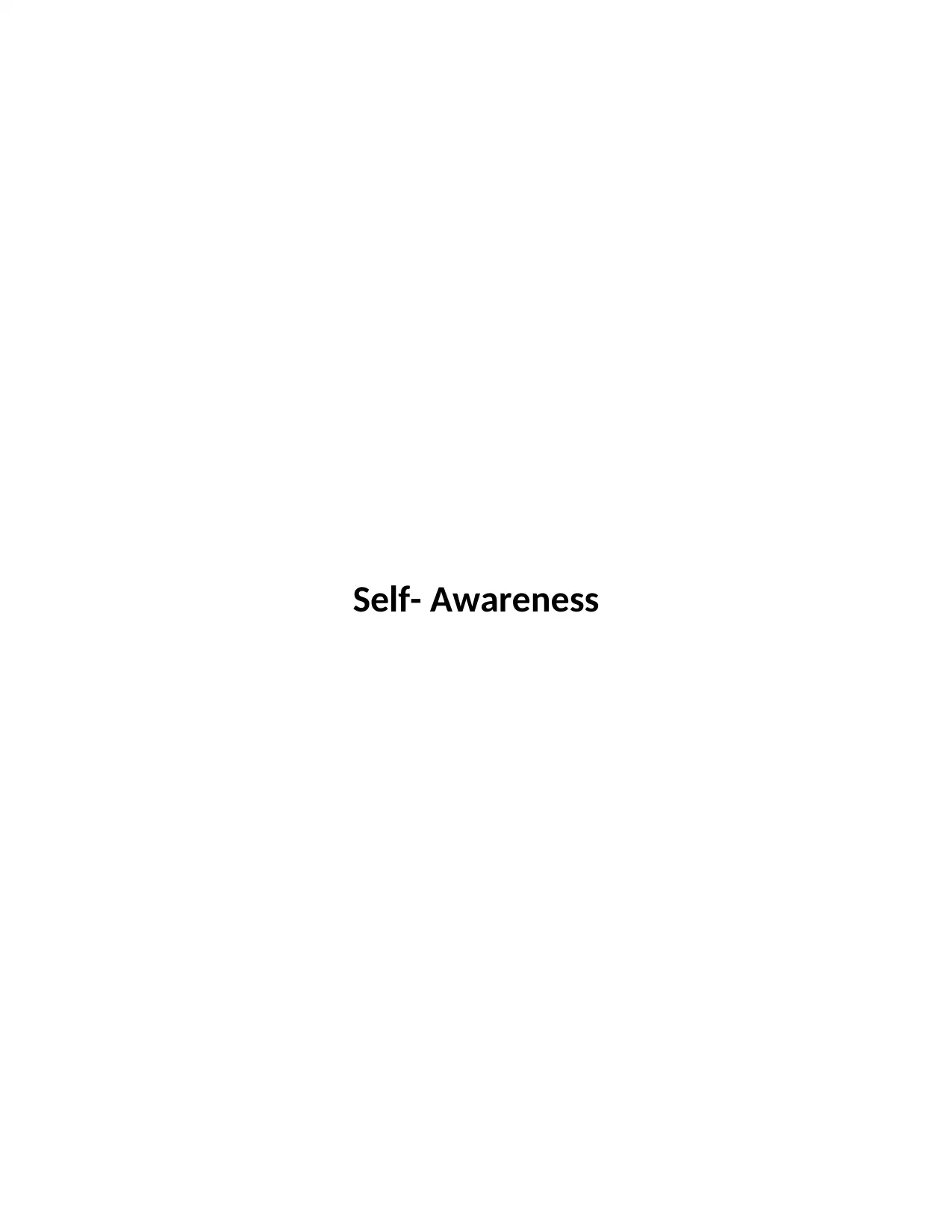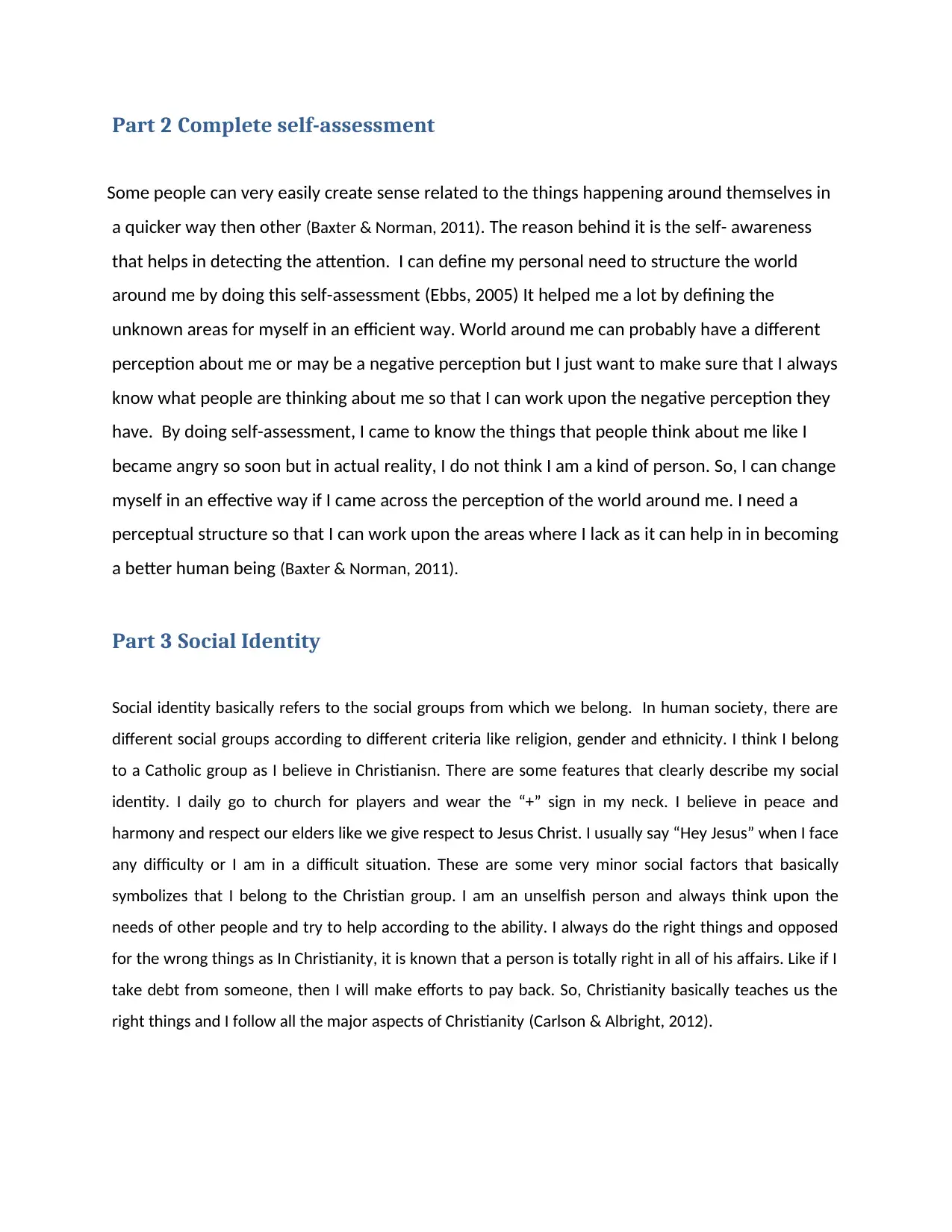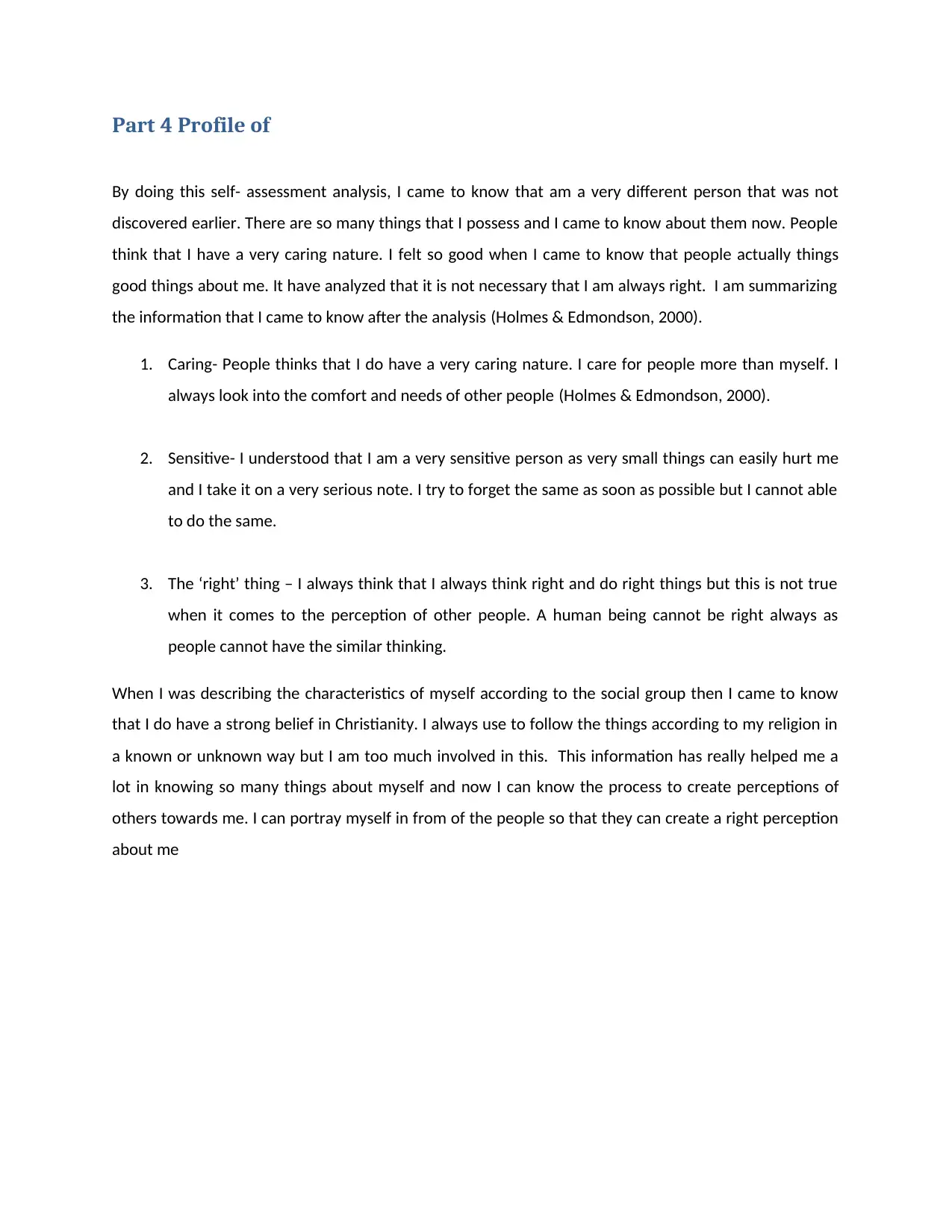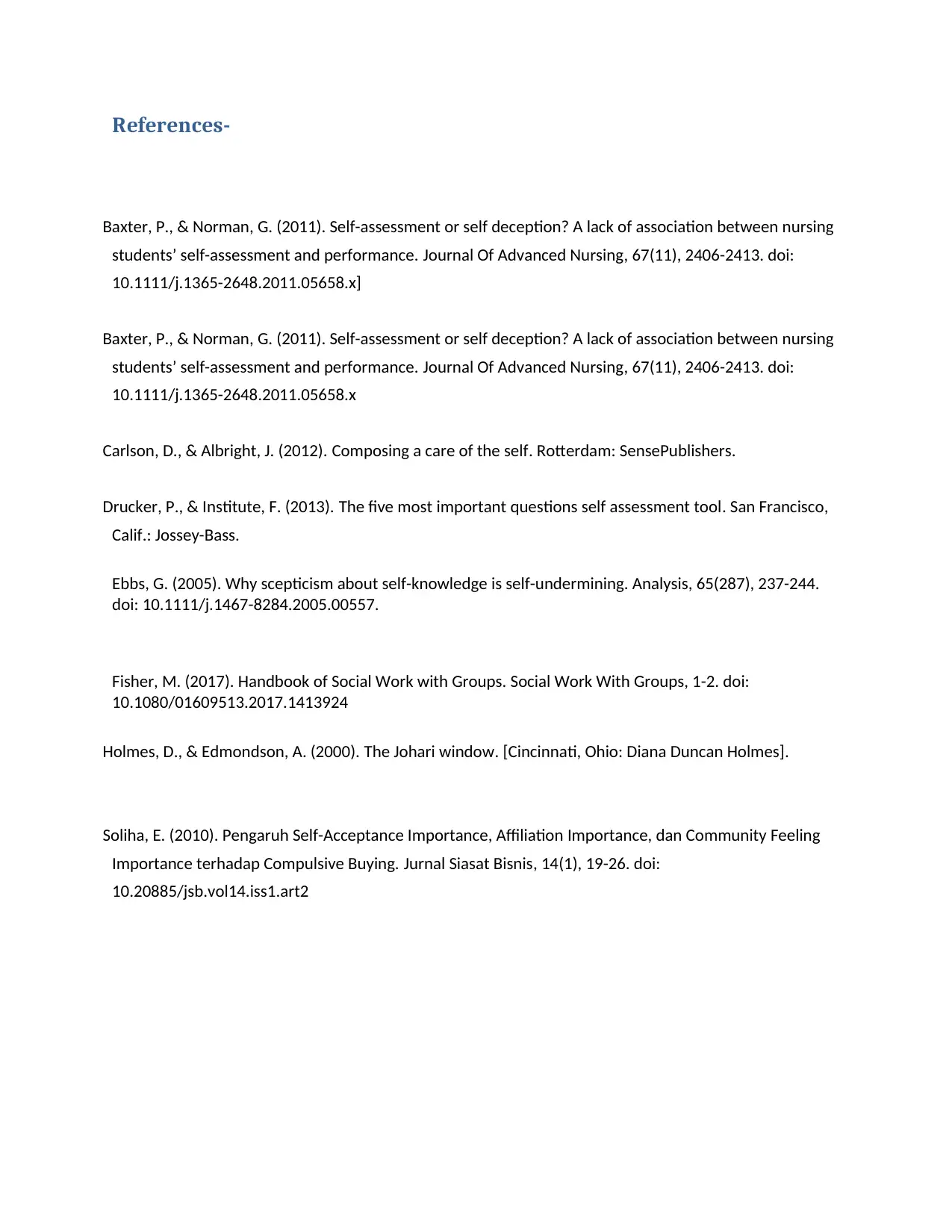Essay on Self-Awareness: Johari Window and Social Identity Analysis
VerifiedAdded on 2023/06/10
|6
|1443
|405
Essay
AI Summary
This essay delves into the concept of self-awareness through a comprehensive self-assessment process, employing the Johari Window model to analyze personal strengths, weaknesses, and perceptions. It explores the author's social identity, particularly within a religious context, reflecting on how personal beliefs and actions align with their identified social group. The essay concludes with a profile summarizing key insights gained from the self-assessment, highlighting aspects such as caring nature, sensitivity, and the importance of aligning personal actions with values. This reflective analysis aims to enhance self-understanding and improve interpersonal relationships by addressing potential discrepancies between self-perception and external perceptions. Desklib provides this essay as a resource for students studying self-awareness and personal development.

Self- Awareness
Paraphrase This Document
Need a fresh take? Get an instant paraphrase of this document with our AI Paraphraser

Contents
Introduction-...............................................................................................................................................3
Part 1 Johari Window.................................................................................................................................3
Part 2 Complete self-assessment................................................................................................................4
Part 3 Social Identity....................................................................................................................................4
Part 4 Profile of............................................................................................................................................5
References-.................................................................................................................................................6
Introduction-...............................................................................................................................................3
Part 1 Johari Window.................................................................................................................................3
Part 2 Complete self-assessment................................................................................................................4
Part 3 Social Identity....................................................................................................................................4
Part 4 Profile of............................................................................................................................................5
References-.................................................................................................................................................6

Introduction-
Self-assessment means a process in which a person tries to find out the strongest areas, weakest areas
and certain important aspects that basically defines the nature of the same. Self-assessment is
necessary because, an individual feel so depressed and left out when people create some negative
perceptions about the individual.
Part 1 Johari Window
Self-assessment refers to the assessment of an individual by himself in order to assess the qualities,
strengths and weakness. For doing the self-assessment, Johari window has been designed by Joseph Luft
and Harry Ingham in 1955 in order to help the people in different ways by which they can start knowing
themselves in a much better way. It usually helps in finding out the relationships with other people and
the need of self-improvement. By doing this analysis, with the help of Johari window a person can able
to know the areas where he lacks and need to work upon. There are some rooms that need to be
analyzed while building Johari window (Soliha, 2010).
1. Open-self room- There is some qualities that an individual think, he possess and the other
people thinks the same about him. So, these are the common qualities that have been selected
by self and the other person who is participation with you in this activity.
2. Blind- Self room- These are the qualities that people think an individual possess, but he do not
think the same. In this, an individual came to know about different qualities that he has but he
have no idea about it. These are also known as blind spots (Drucker & Institute, 2013).
3. Hidden- self room- These are the qualities that have been selected by the individual and he
thinks that he has those qualities, but other people do not think about the same. It helps in
knowing the perception an individual has created for himself (Fisher, 2017).
Self-assessment means a process in which a person tries to find out the strongest areas, weakest areas
and certain important aspects that basically defines the nature of the same. Self-assessment is
necessary because, an individual feel so depressed and left out when people create some negative
perceptions about the individual.
Part 1 Johari Window
Self-assessment refers to the assessment of an individual by himself in order to assess the qualities,
strengths and weakness. For doing the self-assessment, Johari window has been designed by Joseph Luft
and Harry Ingham in 1955 in order to help the people in different ways by which they can start knowing
themselves in a much better way. It usually helps in finding out the relationships with other people and
the need of self-improvement. By doing this analysis, with the help of Johari window a person can able
to know the areas where he lacks and need to work upon. There are some rooms that need to be
analyzed while building Johari window (Soliha, 2010).
1. Open-self room- There is some qualities that an individual think, he possess and the other
people thinks the same about him. So, these are the common qualities that have been selected
by self and the other person who is participation with you in this activity.
2. Blind- Self room- These are the qualities that people think an individual possess, but he do not
think the same. In this, an individual came to know about different qualities that he has but he
have no idea about it. These are also known as blind spots (Drucker & Institute, 2013).
3. Hidden- self room- These are the qualities that have been selected by the individual and he
thinks that he has those qualities, but other people do not think about the same. It helps in
knowing the perception an individual has created for himself (Fisher, 2017).
⊘ This is a preview!⊘
Do you want full access?
Subscribe today to unlock all pages.

Trusted by 1+ million students worldwide

Part 2 Complete self-assessment
Some people can very easily create sense related to the things happening around themselves in
a quicker way then other (Baxter & Norman, 2011). The reason behind it is the self- awareness
that helps in detecting the attention. I can define my personal need to structure the world
around me by doing this self-assessment (Ebbs, 2005) It helped me a lot by defining the
unknown areas for myself in an efficient way. World around me can probably have a different
perception about me or may be a negative perception but I just want to make sure that I always
know what people are thinking about me so that I can work upon the negative perception they
have. By doing self-assessment, I came to know the things that people think about me like I
became angry so soon but in actual reality, I do not think I am a kind of person. So, I can change
myself in an effective way if I came across the perception of the world around me. I need a
perceptual structure so that I can work upon the areas where I lack as it can help in in becoming
a better human being (Baxter & Norman, 2011).
Part 3 Social Identity
Social identity basically refers to the social groups from which we belong. In human society, there are
different social groups according to different criteria like religion, gender and ethnicity. I think I belong
to a Catholic group as I believe in Christianisn. There are some features that clearly describe my social
identity. I daily go to church for players and wear the “+” sign in my neck. I believe in peace and
harmony and respect our elders like we give respect to Jesus Christ. I usually say “Hey Jesus” when I face
any difficulty or I am in a difficult situation. These are some very minor social factors that basically
symbolizes that I belong to the Christian group. I am an unselfish person and always think upon the
needs of other people and try to help according to the ability. I always do the right things and opposed
for the wrong things as In Christianity, it is known that a person is totally right in all of his affairs. Like if I
take debt from someone, then I will make efforts to pay back. So, Christianity basically teaches us the
right things and I follow all the major aspects of Christianity (Carlson & Albright, 2012).
Some people can very easily create sense related to the things happening around themselves in
a quicker way then other (Baxter & Norman, 2011). The reason behind it is the self- awareness
that helps in detecting the attention. I can define my personal need to structure the world
around me by doing this self-assessment (Ebbs, 2005) It helped me a lot by defining the
unknown areas for myself in an efficient way. World around me can probably have a different
perception about me or may be a negative perception but I just want to make sure that I always
know what people are thinking about me so that I can work upon the negative perception they
have. By doing self-assessment, I came to know the things that people think about me like I
became angry so soon but in actual reality, I do not think I am a kind of person. So, I can change
myself in an effective way if I came across the perception of the world around me. I need a
perceptual structure so that I can work upon the areas where I lack as it can help in in becoming
a better human being (Baxter & Norman, 2011).
Part 3 Social Identity
Social identity basically refers to the social groups from which we belong. In human society, there are
different social groups according to different criteria like religion, gender and ethnicity. I think I belong
to a Catholic group as I believe in Christianisn. There are some features that clearly describe my social
identity. I daily go to church for players and wear the “+” sign in my neck. I believe in peace and
harmony and respect our elders like we give respect to Jesus Christ. I usually say “Hey Jesus” when I face
any difficulty or I am in a difficult situation. These are some very minor social factors that basically
symbolizes that I belong to the Christian group. I am an unselfish person and always think upon the
needs of other people and try to help according to the ability. I always do the right things and opposed
for the wrong things as In Christianity, it is known that a person is totally right in all of his affairs. Like if I
take debt from someone, then I will make efforts to pay back. So, Christianity basically teaches us the
right things and I follow all the major aspects of Christianity (Carlson & Albright, 2012).
Paraphrase This Document
Need a fresh take? Get an instant paraphrase of this document with our AI Paraphraser

Part 4 Profile of
By doing this self- assessment analysis, I came to know that am a very different person that was not
discovered earlier. There are so many things that I possess and I came to know about them now. People
think that I have a very caring nature. I felt so good when I came to know that people actually things
good things about me. It have analyzed that it is not necessary that I am always right. I am summarizing
the information that I came to know after the analysis (Holmes & Edmondson, 2000).
1. Caring- People thinks that I do have a very caring nature. I care for people more than myself. I
always look into the comfort and needs of other people (Holmes & Edmondson, 2000).
2. Sensitive- I understood that I am a very sensitive person as very small things can easily hurt me
and I take it on a very serious note. I try to forget the same as soon as possible but I cannot able
to do the same.
3. The ‘right’ thing – I always think that I always think right and do right things but this is not true
when it comes to the perception of other people. A human being cannot be right always as
people cannot have the similar thinking.
When I was describing the characteristics of myself according to the social group then I came to know
that I do have a strong belief in Christianity. I always use to follow the things according to my religion in
a known or unknown way but I am too much involved in this. This information has really helped me a
lot in knowing so many things about myself and now I can know the process to create perceptions of
others towards me. I can portray myself in from of the people so that they can create a right perception
about me
By doing this self- assessment analysis, I came to know that am a very different person that was not
discovered earlier. There are so many things that I possess and I came to know about them now. People
think that I have a very caring nature. I felt so good when I came to know that people actually things
good things about me. It have analyzed that it is not necessary that I am always right. I am summarizing
the information that I came to know after the analysis (Holmes & Edmondson, 2000).
1. Caring- People thinks that I do have a very caring nature. I care for people more than myself. I
always look into the comfort and needs of other people (Holmes & Edmondson, 2000).
2. Sensitive- I understood that I am a very sensitive person as very small things can easily hurt me
and I take it on a very serious note. I try to forget the same as soon as possible but I cannot able
to do the same.
3. The ‘right’ thing – I always think that I always think right and do right things but this is not true
when it comes to the perception of other people. A human being cannot be right always as
people cannot have the similar thinking.
When I was describing the characteristics of myself according to the social group then I came to know
that I do have a strong belief in Christianity. I always use to follow the things according to my religion in
a known or unknown way but I am too much involved in this. This information has really helped me a
lot in knowing so many things about myself and now I can know the process to create perceptions of
others towards me. I can portray myself in from of the people so that they can create a right perception
about me

References-
Baxter, P., & Norman, G. (2011). Self-assessment or self deception? A lack of association between nursing
students’ self-assessment and performance. Journal Of Advanced Nursing, 67(11), 2406-2413. doi:
10.1111/j.1365-2648.2011.05658.x]
Baxter, P., & Norman, G. (2011). Self-assessment or self deception? A lack of association between nursing
students’ self-assessment and performance. Journal Of Advanced Nursing, 67(11), 2406-2413. doi:
10.1111/j.1365-2648.2011.05658.x
Carlson, D., & Albright, J. (2012). Composing a care of the self. Rotterdam: SensePublishers.
Drucker, P., & Institute, F. (2013). The five most important questions self assessment tool. San Francisco,
Calif.: Jossey-Bass.
Ebbs, G. (2005). Why scepticism about self-knowledge is self-undermining. Analysis, 65(287), 237-244.
doi: 10.1111/j.1467-8284.2005.00557.
Fisher, M. (2017). Handbook of Social Work with Groups. Social Work With Groups, 1-2. doi:
10.1080/01609513.2017.1413924
Holmes, D., & Edmondson, A. (2000). The Johari window. [Cincinnati, Ohio: Diana Duncan Holmes].
Soliha, E. (2010). Pengaruh Self-Acceptance Importance, Affiliation Importance, dan Community Feeling
Importance terhadap Compulsive Buying. Jurnal Siasat Bisnis, 14(1), 19-26. doi:
10.20885/jsb.vol14.iss1.art2
Baxter, P., & Norman, G. (2011). Self-assessment or self deception? A lack of association between nursing
students’ self-assessment and performance. Journal Of Advanced Nursing, 67(11), 2406-2413. doi:
10.1111/j.1365-2648.2011.05658.x]
Baxter, P., & Norman, G. (2011). Self-assessment or self deception? A lack of association between nursing
students’ self-assessment and performance. Journal Of Advanced Nursing, 67(11), 2406-2413. doi:
10.1111/j.1365-2648.2011.05658.x
Carlson, D., & Albright, J. (2012). Composing a care of the self. Rotterdam: SensePublishers.
Drucker, P., & Institute, F. (2013). The five most important questions self assessment tool. San Francisco,
Calif.: Jossey-Bass.
Ebbs, G. (2005). Why scepticism about self-knowledge is self-undermining. Analysis, 65(287), 237-244.
doi: 10.1111/j.1467-8284.2005.00557.
Fisher, M. (2017). Handbook of Social Work with Groups. Social Work With Groups, 1-2. doi:
10.1080/01609513.2017.1413924
Holmes, D., & Edmondson, A. (2000). The Johari window. [Cincinnati, Ohio: Diana Duncan Holmes].
Soliha, E. (2010). Pengaruh Self-Acceptance Importance, Affiliation Importance, dan Community Feeling
Importance terhadap Compulsive Buying. Jurnal Siasat Bisnis, 14(1), 19-26. doi:
10.20885/jsb.vol14.iss1.art2
⊘ This is a preview!⊘
Do you want full access?
Subscribe today to unlock all pages.

Trusted by 1+ million students worldwide
1 out of 6
Related Documents
Your All-in-One AI-Powered Toolkit for Academic Success.
+13062052269
info@desklib.com
Available 24*7 on WhatsApp / Email
![[object Object]](/_next/static/media/star-bottom.7253800d.svg)
Unlock your academic potential
Copyright © 2020–2025 A2Z Services. All Rights Reserved. Developed and managed by ZUCOL.





